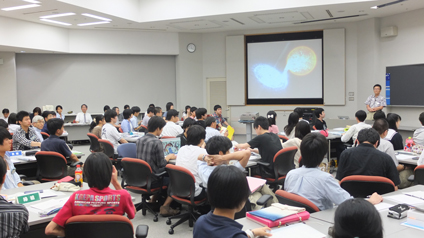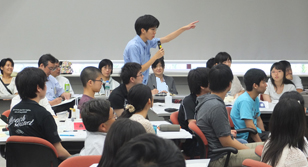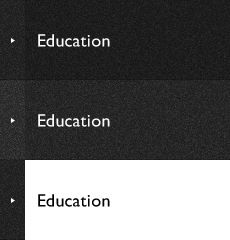Tokyo Tech's High School-University Collaboration in Education
Tokyo Tech has been offering opportunities for high school students in the Tokyo Tech High School of Science and Technology to experience university-level education since 2004. The purpose of this collaborative education is for high-school students to develop a vision of their future and then go on to university with clear objectives, making university education a natural extension of their high school education. It also aims to cultivate leaders in the fields of science and technology.
The collaborative education is comprised of three programs: Open Campus, Summer Lectures and the Summer Challenge. At Open Campus, all 1st-year students of the Tokyo Tech High School of Science and Technology visit several Tokyo Tech laboratories to spark their interest in science and technology. Summer Lectures is a one-day event for all 2nd-year students of the high school. They attend lectures given by Tokyo Tech faculty members, and then visit laboratories of their choice to gain firsthand experience in cutting-edge research. At the two-day-three-night Summer Challenge, about fifty 3rd-year students, selected from a pool of applicants, tackle six challenges, which are more complex than those they typically confront at high school.
Summer Challenge 2013
The Summer Challenge 2013 marked the program's tenth year and was held again at Shonan Village on the Miura Peninsula. Fifty-two high school students in their final and 3rd-year participated this summer: 43 students from the Tokyo Tech High School of Science and Technology and 9 from Ochanomizu University Senior High School.
Each year six challenges await the students at the site prepared by Tokyo Tech faculty after much deliberation. All the challenges are aimed at getting students to come up with their own ideas and encourage flexibility by giving students lectures and exercises at the university level. Additionally, the Summer Challenge is designed to develop their ability to create plans and draw out their individuality through experiments and teamwork. Participating students only learn what the six challenges are on the first day of the Summer Challenge.
Outline of the Summer Challenge 2013
Dates: |
August 6 - 8, 2013 |
Place: |
International Productivity Center,Shonan Village in Hayama, Kanagawa |
Number of participating students: |
52
Tokyo Tech High School of Science and Technology - 43 Ochanomizu University Senior High School - 9 |
Number of participating faculty: |
30
Tokyo Tech - 22
Tokyo Tech High School of Science and Technology - 5 Ochanomizu University Senior High School - 3 |
Number of participating administrative staff: |
10 |
Number of faculty observers: |
8 |
Total number of people: |
100 |
Challenge 1: Meteorite Challenge
Let's estimate the size of the meteorite that hit Russia in February!

The Summer Challenge 2013 started off with a video of a meteorite falling from the sky. "All you have is this grainy YouTube video, and yet we will see that when we apply sound scientific reasoning to this video, we can get information. Now, how many seconds did it take from when you saw the lightning until the arrival of the shock wave? How many times lighter is the meteorite than the sun?" Professor Nobuyuki Kawai from the Department of Physics (Particle-, Nuclear- and Astro-Physics) skillfully guided the session. Students were divided into groups, then calculated and estimated figures one after another. "You can approach NASA with your knowledge of high school-level physics!" The Meteorite Challenge extinguished students' worries about not being able to follow university-level lectures.
Challenges 2 and 3: Disassembly Challenge
Let's disassemble things around you!

On the table were mechanical pencils, 100-yen quartz clocks and two kinds of packaged soy sauce. The pencil's automatically revolving lead mechanism maintains a continually sharp point. The quartz clock was an analogue type. One of the soy sauce packages was vacuum packed in a special pouch equipped with a check valve. The other was in a special double-layered soft bottle with a check valve. Both the pouch and bottle were designed to prevent the soy sauce from being exposed to air. "How can the spout of the pouch be tightly sealed without any additional components? Why doesn't air enter the bottle even when the amount of the soy sauce in the bottle decreases?" Under the guidance of Professor Kazuo Shinozaki of the Department of Metallurgy and Ceramics Science, students disassembled objects, observed them from a variety of angles and analyzed them. The aim of this challenge was to have students disassemble ordinary things around them and find out how materials and structures are designed for specific functions. The following day, each group gave presentations on the mechanisms of the things they disassembled.
Challenge 5: Sleeping Chironomid Challenge
Let's revive a sleeping chironomid!

Professor Minoru Sakurai of the Department of Biomolecular Engineering radiantly distributed dormant chironomid larvae, which look like very tiny shrimp crackers. There were digital microscopes and monitors on each group's table. The dormant chironomid larvae were born on bedrock of 50 degrees C in Nigeria, where they typically grow in a waterless environment. The larvae's vitrified trehalose allows them to withstand the heat and protect their cells.
"Slowly pour hot water onto the larvae to revive them," Professor Sakurai said. The students then waited for thirty minutes while they conducted an experiment to identify trehalose and sucrose. "It's moving!" the first group cheered. The head of a red, dry larva turned white, slowly trembled and soon started to swim so powerfully that it almost moved out of the field of vision of the microscope. At each of the tables twelve eyes were watching their monitors. This exciting moment of reviving a larva will be an important memory in the growth of young scientists.
Challenge 4 was the "Management engineering of cutting thin bamboo sticks" led by Associate Professor Hirotaka Aoki of the Department of Industrial Engineering and Management. Challenge 6 was the "Chemical Engineering of heat and cold" led by Professor Akira Ito of the Department of Chemical Engineering. All participating students overcame the six challenges and completed the three-day program.
Plans for the Next Ten Years
In 2011, the eighth year of the Summer Challenge, the all-girl Ochanomizu University Senior High School began participating in the event. Students felt highly motivated to collaborate with students from different backgrounds and were more engaged in the tasks than in previous years. In light of this, Tokyo Tech is considering opening up the program to more high schools.
To mark the tenth anniversary of the program, Tokyo Tech invited high school teachers from non-participant schools to this year's Summer Challenge. Eight high schools, two affiliated high schools of national universities and six integrated junior- and senior-high schools participated and exchanged meaningful information. The positive feedback of "We would very much like our students to participate," and lots of suggestions for the improvement of the program were given by observers who work at the forefront of high school education. With the accumulated power of ten-year's know-how and knowledge, the Summer Challenge continues to evolve.
Kyoko Yamamuro
Chairperson, Committee for Undergraduate Admissions, High School-University Collaboration in Education
The Special Topics component of the Tokyo Tech Website shines a spotlight on recent developments in research and education, achievements of its community members, and special events and news from the Institute.
Past features can be viewed in the Special Topics Gallery.
Published: September 2013
. Any information published on this site will be valid in relation to Science Tokyo.











